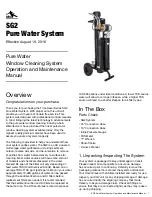
© Copyright 2012 Zoeller Co. All rights reserved.
STEP 4
OPERATIONAL TEST OF COMPLETE SySTEM
4.1) With the cover removed, temporarly connect the discharge pipe.
NOTE: At this point the pit is filled with water and the float is
in the “on” position.
4.2) Plug the float switch into the outlet and the pump plug into the float
plug. (Refer to Figure 4.2) The pump should immediately empty
the pit, if the pump does not turn “on” continue filling the pit with
water.
NOTE: If the pump does not turn “on/off”, and the float is in
the vertical position and/or submerged, refer to the trouble
-
shooting guide at the end of this manual.
4.3) Verify that the pump cycles on and that the desired “pump-down”
range is acceptable.
4.4) Repeat manual cycling of pump as necessary to insure proper
operation.
4.5) Unplug the pump, disconnect the discharge pipe, replace cover
and complete the installation as shown in Figure 4.2.
If the above check list does not uncover the problem, consult the factory - do not attempt to service or otherwise disassemble pump. Service must be by
Zoeller Authorized Service Stations.
TROUBLE SHOOTING GUIDE
ELECTRICAL PRECAUTIONS- Before servicing a pump, always shut off the main power breaker and then unplug the pump - making sure you are not standing in
water and are wearing insulated protective sole shoes. Under flooded conditions, contact your local electric company or a qualified licensed electrician for disconnecting electrical service
prior to pump removal.
Submersible pumps contain oils which becomes pressurized and hot under operating conditions - allow 2½ hours after disconnecting before attempting service.
NOTE: If too little water is removed, adjust the tether length per STEP 2.
IMPORTANT! Repeat Step 3 & 4 if tether length is adjusted.
Figure 4.2
CONdITION
COMMON CAUSES
Check fuse, low voltage, overload open, open or incorrect wiring, open switch, impeller or seal
bound mechanically, defective capacitor or relay when used, motor or wiring shorted. Float as-
sembly held down. Switch defective, damaged, or out of adjustment.
Incorrect voltage, negative head (discharge open lower than normal) impeller or seal bound
mechanically, defective capacitor or relay, motor shorted.
Check valve stuck or none installed in long discharge line, overload open, level switch(s) defec-
tive, sump pit too small.
Debris under float assembly, float bound by pit sides or other obstruction, switch defective, dam-
aged or out of adjustment.
Check strainer housing, discharge pipe, or if check valve is used vent hole must be open. Dis-
charge head exceeds pump capacity. Low or incorrect voltage. Incorrect motor rotation. Capacitor
defective. Incoming water containing air or causing air to enter pump.
Increased pipe friction, clogged line or check valve. Abrasive material and adverse chemicals
could possibly deteriorate impeller and pump housing. Check line. Remove base and inspect.
A. Pump will not start or run.
B. Motor overheats and trips overload or blows fuse.
C. Pump starts and stops too often.
d. Pump will not shut off.
E. Pump operates but delivers little or no water.
F. drop in head and/or capacity after a period of use.
SK2070
STEP 3
VISUAL INSPECTION OF COMPLETE SySTEM
3.1) With the pit cover removed and the pump unplugged, fill the pit with water.
3.2) As the pit is filling, verify that the float travel is not obstructed by the wall or any other object.
3.3) If the float is obstructed, remove obstruction and or adjust the tether length per STEP 2.






















